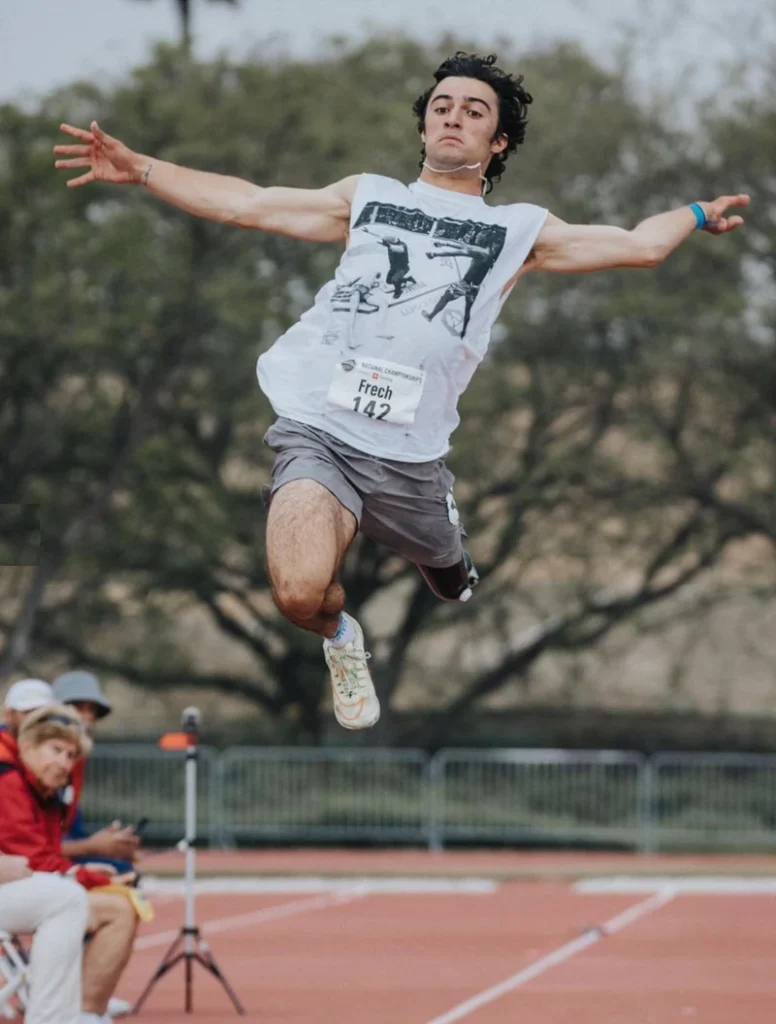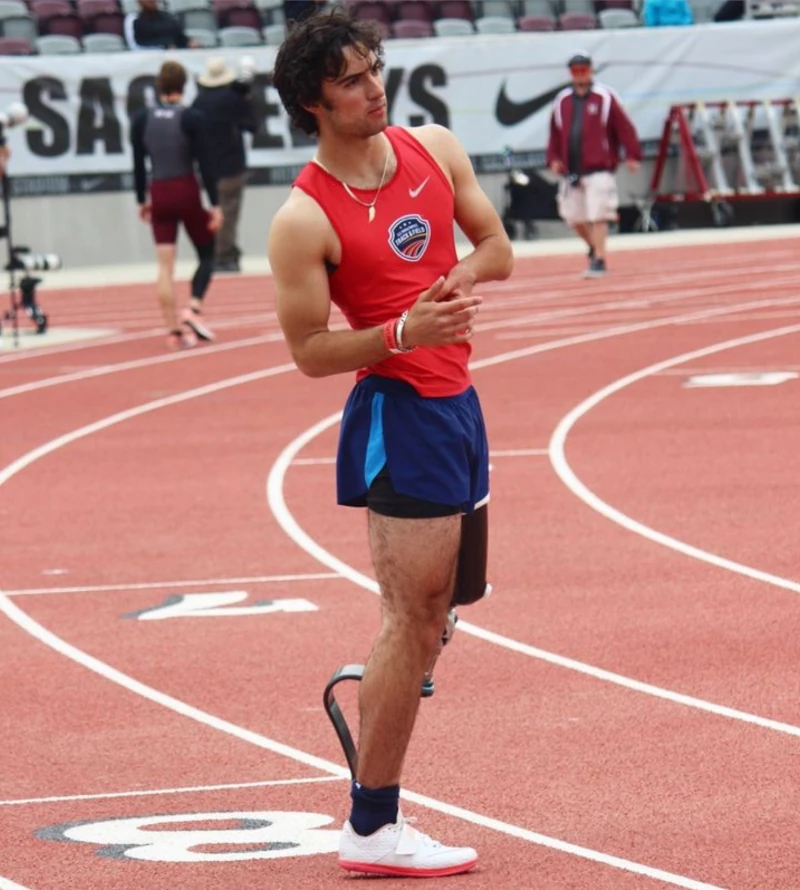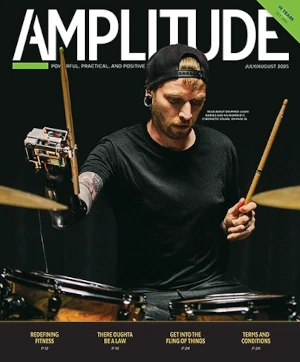
It was a bit jarring to see photos of Ezra Frech in cap and gown earlier this month, holding his high school diploma. Can he really only be 18 years old? Frech has been chasing medals on the global stage since before the pandemic, so he profiles more like a guy in his mid-20s. Ever the competitor, he set a new world record in the high jump (T63 classification) two weeks after his graduation ceremony. Frech heads off to the World Para Athletics Championships next month in prime position to win at least one gold medal.
But before then, Frech will assume the other role that makes him seem older and wiser than his age: adaptive sports ambassador. He’ll be co-hosting the 9th annual Angel City Games, which his family launched when (do the math) lil’ Ez was just a grade-schooler. The event starts tomorrow and runs through Sunday, July 2, and it’s billed as the largest celebration of adaptive sports on the West Coast. The slate of activities includes nearly 20 different sports, along with music, food, and other entertainment. It’s an LA gig, so of course there’s some star power involved. But the focus, as always, will be on the community of adaptive athletes (young and old) who are there to learn, compete, goof around, and connect with peers.
“That’s what we’re here for,” says Frech. “It’s nice to finally have a full-fledged event that brings the community together in a way that hasn’t really been done since before the pandemic. That’s super exciting for us.”
We caught up with Frech last week to find out what’s new and improved about this year’s Angel City Games, and to get his impressions about the state of adaptive sports more broadly. If you’re in the SoCal area, registration for this weekend’s event is still open. The schedule of clinics and competitions is here.
Our conversation is edited for length.
It feels like the last vestiges of COVID interference are finally gone, and you’re getting to take a full swing at the Angel City Games this year. Is that an accurate impression?
A hundred percent. That’s completely an accurate impression. COVID has impacted us a lot. Trying to run a nonprofit and host in-person events during the pandemic has been very difficult. We had our virtual games, and we had games that were sort of in-between, but now we’re 100% back. And that’s what’s super exciting about this year’s games. We can finally have a full fledged event that brings the community together in a way that hasn’t really been done since the beginning of the pandemic.
Will you be introducing any new elements for this year’s iteration of Angel City?
We have the Hartford Experience Zone this year, where anyone can experience what it’s like to participate in adaptive sports. The purpose of the Experience Zone is to give able-bodied people a way to understand adaptive sports at a deeper level, whether that’s through playing wheelchair basketball, or playing table tennis while sitting, or trying to golf swing with one arm, or anything along those lines. The whole purpose is to give our able-bodied friends and allies an experience that resonates for them. Big shout-out to the Hartford for sponsoring that and getting that going.
Another really exciting piece is that we have a new location. We were originally at UCLA, and then we bounced around once the pandemic came along. But I think we’ve found our home at USC, which is super exciting. It’s in the heart of LA, and it’s in touch with the community we have. It’s such an accessible campus, super-flat and easy to get around for anyone in a wheelchair. And they’ve been a fantastic partner. So I think we’ve found our home for this summer and hopefully continuing in the future.
Overall, we’ll have 15 Paralympic sports around maybe 20-plus Paralympians. There’s a celebrity wheelchair basketball game on Friday. We’ll have a sports-resource night on Saturday, and there’s a fun run and lots of dinners and lunches. For everyday attendees, we’ll have basketball, rowing, golf, volleyball, fitness, track and field—all these these sport opportunities for people to jump right in.
Where do you think Angel City is experiencing the fastest growth? Is there one particular sports or population that’s really blowing up these days?
That’s a great question. Our top performing sports are wheelchair basketball and track. We usually get the most most athletes there. Archery is super, super popular. People love archery. We started a wheelchair football team in the past couple years, and that’s been super popular. We have a golf program now, and people are loving the golf clinics. We have programs in table tennis, rowing, swimming—all of that will be happening at the Angel City Games. But its been fun to watch the wheelchair football and golf programs take off. There’s buzz around all of the sports, but those are the first ones that come to mind that are really gaining a lot of interest.
Have you played wheelchair football yourself?
Oh yeah. Absolutely love it.

Doesn’t Angel City sponsor the LA Rams affiliate in the National Wheelchair Football League?
That is correct. We lost to the Chiefs at the NWFL Super Bowl earlier this year. The goal is that eventually each of the NFL teams will have their own wheelchair football team. We’re getting closer and closer to reaching that milestone. It’s so much fun to watch. It’s pretty gnarly. I mean, these guys are going full speed, ramming into each other and crashing and falling. It’s quite entertaining. You are missing out if you have yet to see it in person.
Angel City is helping to drive the growth of parasports at a macro level. Is there anything you see that’s happening nationally or internationally that really encourages you?
There’s so much demand out there. We know our numbers can be way higher, given how many people with physical disabilities are out there. We’d like to see tens of thousands of people with physical disabilities coming out to the Angel City Games, our clinics, and other events throughout the year. That’s the motivation for us. We know the community is there, we know there are thousands of people who don’t understand that adaptive sports are possible for them, and who are told by society that they’re not meant to do sports. They’re often living lives of isolation, and we know the power of the sports in bring people together. That’s what we’re here to do.
What do you think are the barriers that are holding back progress?
A lot of obstacles and challenges come to mind. Number one is awareness. The main issue is that most people with a physical disability don’t know they have an opportunity to participate in adaptive sports. That’s always been a huge focus for us at Angel City, which is how can we kill the media coverage so that all people with physical disabilities will know what the possibilities are? Getting the media to pay attention and tell the stories is the best way for us to reach as many people as possible, recruit new athletes, and get people to understand what adaptive sports is. And then obviously, that’s how the word spreads. That’s how we get our 15 percent of the US population, or 50 million Americans, to participate in adaptive sports.
I would say the second issue is having localized programs. When I was growing up, LA was sort of a black hole for adaptive sports. There wasn’t anything here, so my dad and I had to create these opportunities for the LA community. Previously, there was nothing. So if you’re living in a place that does not have adaptive sports opportunities, you have to travel. And if you don’t have the financial means to do that, it’s just a mess. So having localized programming is crucial. But it has to be very, very high-level programming. We want to make sure that it’s broad. If you’re coming to an Angel City Sports event for the first time, and you don’t know what sport you’re gonna like, we’re doing all these multi-sport days where you’re bound to like one of them, and you’re bound to fall in love with the community and connect in some way. So I think it comes down to having the right programming around the US on a national scale, and then building up awareness. If we can solve those two pieces of the puzzle, I think the landscape looks completely different.
I definitely took notice of the US Ski and Para Ski teams merging into a single team. Is that sort of merger potentially helpful in raising visibility, raising awareness, helping to educate people and bring more media attention?
I believe so. Just as when, a couple of years ago, the US Olympic Committee became the US Olympic and Paralympic Committee, all these things continue to drive understanding.
Are you aware of any conversations about mergers in other sports? Do the athletes talk about it?
There’s chatter about it. That combination can be a positive thing, or it can be a negative thing, depending on the way it’s set up. But I do believe that everyone wants to see the growth of the Paralympics. There are differing opinions about the ways in which that ends up happening.
Another question I wanted to ask you about is the cost of adaptive sports.A number of states introduced legislation this year to eliminate some of the loopholes that insurers use to deny coverage for recreational or athletic prosthetics. Have you paid attention to that at all?
That type of stuff is what what gives me hope and gives me fuel. That stuff is super exciting. It’s very difficult for anyone with a physical disability to pay out of their own pocket just to be able to run. And I think that’s a crime. I’m glad we’re taking steps in the right direction. One of the things we do at Angel City is loan out equipment, because we know how expensive it can be. We know how difficult it is to access running prosthetics or racing wheelchairs, and most people are not in a financial position to go out of their own pocket.
Almost as soon as the Angel City Games end, you’re off to Paris for the World Championships. How are you feeling about your performance level heading into that meet?
I feel I’m in a strong position. I’m prepared to go out there and win a gold medal in one, maybe two of my events. I’m definitely planning to walk away as the men’s T63 high jump world champion, and I believe I’m very competitive and can put up a good fight in my other events as well. A lot has changed in these four years (since the 2019 Worlds in Dubai). Back then I was small 14-year-old kid who was doing this after school. Now I’m taking a year off to commit my entire life to this. I’m going up against guys who do this full-time—this is their job, it’s how they put food on their table. I have to be just as dedicated.
I saw that you jumped 1.95 not long ago [and set a new world record].
That was a really special moment, breaking my first world record. Hopefully there are many more to come. But it’s more a sign that we’re moving in the right direction rather than some sort of grand celebratory moment. That moment will come at Worlds. Then I can really be happy and celebrate. Until then, I’m just glad we’re moving the right direction. But by no means am I satisfied.




